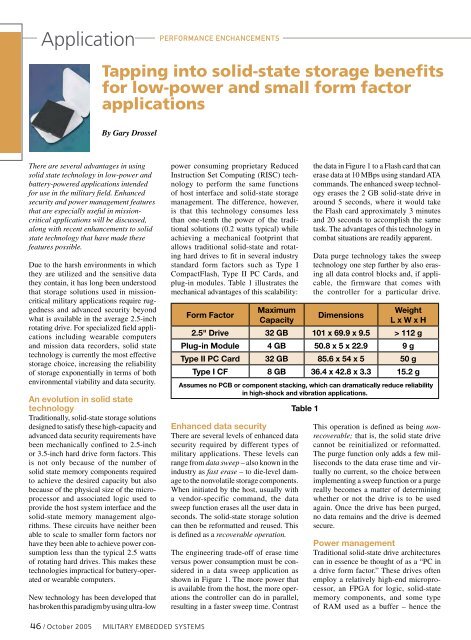Military Embedded Systems - Fall 2005 - Volume 1 Number 2
Military Embedded Systems - Fall 2005 - Volume 1 Number 2
Military Embedded Systems - Fall 2005 - Volume 1 Number 2
You also want an ePaper? Increase the reach of your titles
YUMPU automatically turns print PDFs into web optimized ePapers that Google loves.
Application<br />
Performance enchancements<br />
Tapping into solid-state storage benefits<br />
for low-power and small form factor<br />
applications<br />
By Gary Drossel<br />
There are several advantages in using<br />
solid state technology in low-power and<br />
battery-powered applications intended<br />
for use in the military field. Enhanced<br />
security and power management features<br />
that are especially useful in missioncritical<br />
applications will be discussed,<br />
along with recent enhancements to solid<br />
state technology that have made these<br />
features possible.<br />
Due to the harsh environments in which<br />
they are utilized and the sensitive data<br />
they contain, it has long been understood<br />
that storage solutions used in missioncritical<br />
military applications require ruggedness<br />
and advanced security beyond<br />
what is available in the average 2.5-inch<br />
rotating drive. For specialized field applications<br />
including wearable computers<br />
and mission data recorders, solid state<br />
technology is currently the most effective<br />
storage choice, increasing the reliability<br />
of storage exponentially in terms of both<br />
environmental viability and data security.<br />
An evolution in solid state<br />
technology<br />
Traditionally, solid-state storage solutions<br />
designed to satisfy these high-capacity and<br />
advanced data security requirements have<br />
been mechanically confined to 2.5-inch<br />
or 3.5-inch hard drive form factors. This<br />
is not only because of the number of<br />
solid state memory components required<br />
to achieve the desired capacity but also<br />
because of the physical size of the microprocessor<br />
and associated logic used to<br />
provide the host system interface and the<br />
solid-state memory management algorithms.<br />
These circuits have neither been<br />
able to scale to smaller form factors nor<br />
have they been able to achieve power consumption<br />
less than the typical 2.5 watts<br />
of rotating hard drives. This makes these<br />
technologies impractical for battery-operated<br />
or wearable computers.<br />
New technology has been developed that<br />
has broken this paradigm by using ultra-low<br />
power consuming proprietary Reduced<br />
Instruction Set Computing (RISC) technology<br />
to perform the same functions<br />
of host interface and solid-state storage<br />
management. The difference, however,<br />
is that this technology consumes less<br />
than one-tenth the power of the traditional<br />
solutions (0.2 watts typical) while<br />
achieving a mechanical footprint that<br />
allows traditional solid-state and rotating<br />
hard drives to fit in several industry<br />
standard form factors such as Type I<br />
CompactFlash, Type II PC Cards, and<br />
plug-in modules. Table 1 illustrates the<br />
mechanical advantages of this scalability:<br />
Form Factor<br />
Maximum<br />
Capacity<br />
Enhanced data security<br />
There are several levels of enhanced data<br />
security required by different types of<br />
military applications. These levels can<br />
range from data sweep – also known in the<br />
industry as fast erase – to die-level damage<br />
to the nonvolatile storage components.<br />
When initiated by the host, usually with<br />
a vendor-specific command, the data<br />
sweep function erases all the user data in<br />
seconds. The solid-state storage solution<br />
can then be reformatted and reused. This<br />
is defined as a recoverable operation.<br />
The engineering trade-off of erase time<br />
versus power consumption must be considered<br />
in a data sweep application as<br />
shown in Figure 1. The more power that<br />
is available from the host, the more operations<br />
the controller can do in parallel,<br />
resulting in a faster sweep time. Contrast<br />
the data in Figure 1 to a Flash card that can<br />
erase data at 10 MBps using standard ATA<br />
commands. The enhanced sweep technology<br />
erases the 2 GB solid-state drive in<br />
around 5 seconds, where it would take<br />
the Flash card approximately 3 minutes<br />
and 20 seconds to accomplish the same<br />
task. The advantages of this technology in<br />
combat situations are readily apparent.<br />
Data purge technology takes the sweep<br />
technology one step further by also erasing<br />
all data control blocks and, if applicable,<br />
the firmware that comes with<br />
the controller for a particular drive.<br />
Dimensions<br />
Weight<br />
L x W x H<br />
2.5" Drive 32 GB 101 x 69.9 x 9.5 > 112 g<br />
Plug-in Module 4 GB 50.8 x 5 x 22.9 9 g<br />
Type II PC Card 32 GB 85.6 x 54 x 5 50 g<br />
Type I CF 8 GB 36.4 x 42.8 x 3.3 15.2 g<br />
Assumes no PCB or component stacking, which can dramatically reduce reliability<br />
in high-shock and vibration applications.<br />
Table 1<br />
This operation is defined as being nonrecoverable;<br />
that is, the solid state drive<br />
cannot be reinitialized or reformatted.<br />
The purge function only adds a few milliseconds<br />
to the data erase time and virtually<br />
no current, so the choice between<br />
implementing a sweep function or a purge<br />
really becomes a matter of determining<br />
whether or not the drive is to be used<br />
again. Once the drive has been purged,<br />
no data remains and the drive is deemed<br />
secure.<br />
Power management<br />
Traditional solid-state drive architectures<br />
can in essence be thought of as a “PC in<br />
a drive form factor.” These drives often<br />
employ a relatively high-end microprocessor,<br />
an FPGA for logic, solid-state<br />
memory components, and some type<br />
of RAM used as a buffer – hence the<br />
46 / October <strong>2005</strong> <strong>Military</strong> EMBEDDED SYSTEMS
















